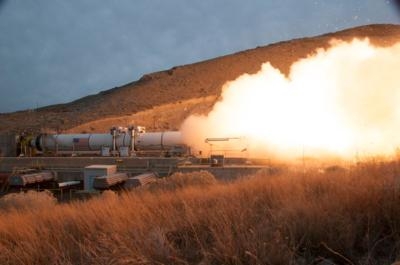Successful Orbital ATK Five-segment Motor Qualification Test Demonstrates Progress On NASA’s Space Launch System
Data from the first five-segment qualification motor (QM-1) test conducted by Orbital ATK and NASA show the solid rocket motor performed as designed. Manufactured by Orbital ATK, the five-segment motor will be used to provide liftoff and ascent thrust for NASA’s Space Launch System, or SLS.

“Having analyzed the data from QM-1 for a little more than a month, we can now confirm the test was a resounding success,” said Charlie Precourt, Vice President and General Manager of Orbital ATK’s Propulsion Systems Division, and four-time space shuttle astronaut. “These test results, along with the many other milestones being achieved across the program, show SLS is on track to preserve our nation’s leadership in space exploration.”
NASA’s SLS will launch on its first mission, Exploration Mission-1, in just a few years. The SLS vehicle, along with NASA’s Orion crew capsule, will take humans farther into space than ever before.
The QM-1 static test had 102 design objectives and was supported by more than 530 instrumentation channels. A key objective of QM-1 was to test the solid rocket motor performance at high temperature (90 degrees F mean bulk temperature). Current data show the nozzle and insulation performed as expected, and ballistics performance parameters met allowable requirements. Additionally, the thrust vector control and avionics system provided the required command and control of the motor nozzle position.
Orbital ATK’s new five-segment boosters for SLS leverage a flight-proven four-segment design, while implementing technological and performance upgrades including: the addition of a fifth motor segment to provide increased power, an advanced avionics system, a more environmentally friendly motor insulation design, a safer flight termination system, and more efficient and modern processing techniques. These changes were designed to meet performance requirements and increase reliability, while lowering manufacturing costs.
This first test of the SLS qualification phase of testing (QM-1) was preceded by a robust three-test demonstration phase (DM-1, DM-2 and DM-3) that helped to substantiate motor design. The qualification phase will conclude with QM-2, scheduled for next spring, fully demonstrating the motor’s readiness for flight. QM-2 will test the motor performance at the lower temperature limit (40 degrees F), whereas QM-1 tested the upper temperature limits (90 degrees F).
“Ground tests are very important – we strongly believe in testing before flight to ensure lessons-learned occur on the ground and not during a mission,” said Precourt. “With each test we have learned things that enable us to modify the configuration to best meet the needs for the upcoming first flight.”
The next major milestones for SLS include further Boeing core stage development and testing at NASA’s Michoud Assembly Facility, continued testing of Aerojet Rocketdyne’s RS-25 engine at NASA’s Stennis Space Center, and avionics and controls testing at Marshall Space Flight Center.
(Image provided by Orbital ATK)
 ANN's Daily Aero-Linx (05.02.24)
ANN's Daily Aero-Linx (05.02.24) ANN's Daily Aero-Term (05.02.24): Touchdown Zone Lighting
ANN's Daily Aero-Term (05.02.24): Touchdown Zone Lighting Aero-News: Quote of the Day (05.02.24)
Aero-News: Quote of the Day (05.02.24) ANN FAQ: Contributing To Aero-TV
ANN FAQ: Contributing To Aero-TV NTSB Final Report: Cirrus Design Corp SR20
NTSB Final Report: Cirrus Design Corp SR20



